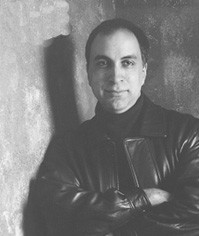
Composer Anthony Cornicello (born in Brooklyn, New York, 1964) writes music that blurs distinctions between performers and electronics, timbre and harmony, composition and improvisation, and explores the boundaries of what may be considered post-classical concert music. His music is vibrant and visceral, full of rhythmic energy and harmonic sophistication, and his forays into live electronics have led to exciting combinations of instruments and processed sound. Cornicello’s background as a jazz pianist is evident not only in the rhythmic activity of his music, but also in his constant investigation of the rich sonorities available from a variety of instruments.
He has been commissioned to write music for the Scorchio Electric String Quartet, ModernWorks! (funding from Meet the Composer/ Commissioning Music USA), the Auros Group for New Music, the Prism Saxophone Quartet, the New York New Music Ensemble, David Holzman, the Group for Contemporary Music, and the InterEnsemble of Padova, Italy. His work has also been featured on the Guggenheim Museum’s “Works and Process” series. Cornicello’s works have also been performed by the Chicago Civic Symphony, Parnassus, ALEA III, Composers Concordance, Madeleine Shapiro, Robert Black, among many other outstanding groups and solo performers. His music has been presented as part of the Darmstadt International Festival of New Music as well as the June in Buffalo Festival.
Cornicello’s Second String Quartet has been recorded by the Atlantic String Quartet; the Second Sonata for Piano by David Holzman (Centaur). More recently, his Post-Modern Waltz was recorded by Eric Moe for Albany Records. A portrait CD of Cornicello’s works is scheduled for 2006 release on Albany Records.
As a performer, he has conducted or played piano in his own works on numerous occasions. While a graduate student at Rutgers, he formed and directed the Janus Ensemble, a group dedicated to contemporary music. More recently, Cornicello has begun performing on the laptop, using a variety of interfaces and the Max/MSP program. Those performances, mostly with EEE!, have had a notable impact on his music, as EEE!’s music ranges from hip-hop to experimental noise. EEE! is based at Eastern Connecticut State University, where Cornicello is an Associate Professor and Director of the Electronic Music Lab.
Cornicello received the Ph.D. from Brandeis University, where he studied with David Rakowski, Eric Chasalow, and Martin Boykan. His teachers also include Charles Wuorinen, Gérard Grisey, and Richard Beirach.
His current fields of interest include developing unusual interfaces for live computer music performances, as well as continuing to investigate resonance and spatialization. His recent and current projects (mostly for string instruments and electronics) have been exploring the latter two, and the series of experimental works ReZenant Garden, performed by EEE! have operated on all three areas of interest. Future projects will include works for instrumental groups or soloists and electronics, as well as turntablists.
Cornicello's works are published by C.F. Peters Corporation and APNM, and he is a member of BMI.
|
|
|
|
|
|

Thursday, January 04, 2007
An interesting question
Recently, I had a friend over and he asked me what I was writing. I told him that I was finishing a piece for ModernWorks, a piece for violin, cello, accordion, and electronics. He asked me what I knew about the accordion, since he is not that familiar with the instrument. I mentioned my meeting with Bill Schimmel (the accordionist for ModernWorks), and how I've read a book and listened to a bunch of things. It's an instrument that isn't really found in orchestration books, and if so, discussed very briefly.
Now, my friend, Jeff Calissi is a percussionist who writes mainly for percussion. Although his pieces are published and played by others, many of the works seem to emanate from his own playing. That is, his writing is based on first-hand experience.
His question to me was, "How do you write for an instrument that you don't play or know that much about?" It's an interesting question! Sometimes, the lack of knowledge is a good thing. You don't have the 'baggage' of accepted techniques to fall back on, and maybe limit your thinking. Now, I do this all the time - I don't play cello, for instance, yet I've written a number of works for cello, and most cellists have told me that it's pretty well written for the instrument. Of course, you could go out and get (the late) Donald Martino's string-o-graph, which gives you a mock fingerboard of the instrument. You'll get a sense of the physicality of the instrument. What you won't get, though is a sense of the sound of the instrument. Sure, you can play certain notes on all four strings - how does it sound on the low C string as opposed to the D string?
Anyway, it's an intriging question. I'm unfortunately thinking of the Aesop Fable where someone asks the centipede which foot he moves first. After that, he's unable to move as he ponders the question!
BTW: an aside about the accordion. It can sustain a note a long time. At my meeting with Bill, we timed out a single note held for around 3 minutes, and he said he could go on longer. Certainly inspired the ending for my piece....
Another odd aside: the accordion has a lot of usual sounds that emerge when playing. Sometimes, a reed will momentarily open from another stop. So, you'll be playing a note, and you'll hear a different overtone emerge and go away - especially on long tones. It's certainly not annoying, but it is quite random. This may have been Bill's instrument, but it's an unusual artifact of the sound.
posted by Anthony Cornicello
|
| |



